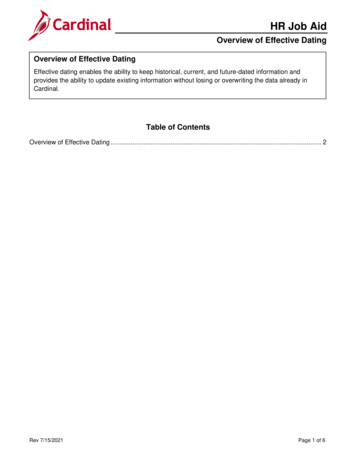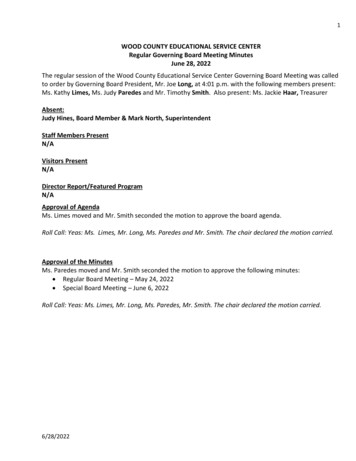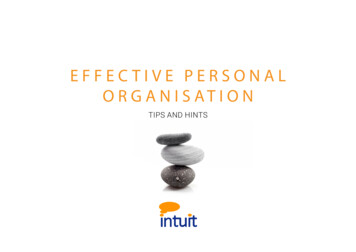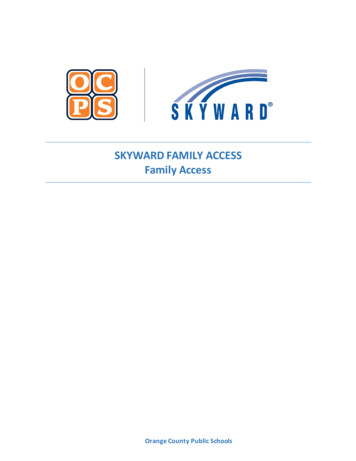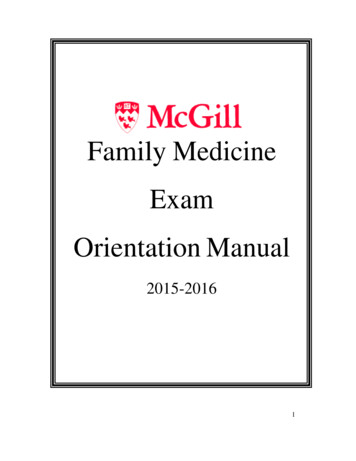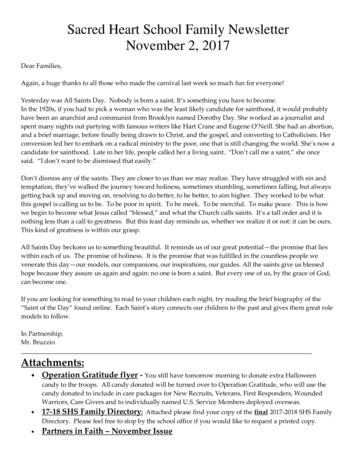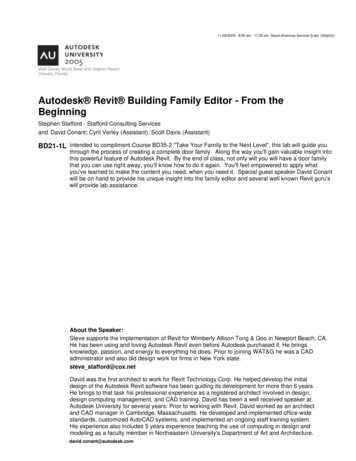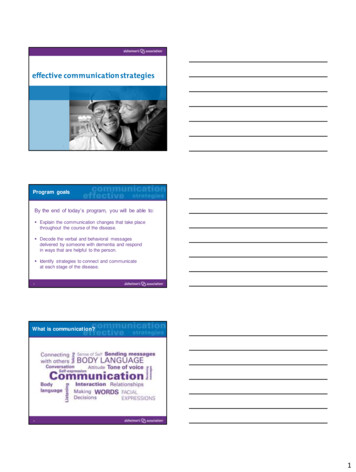
Transcription
FAMILY GUIDE TOEFFECTIVE FAMILYCOUNCILSPrepared for:The Legal Assistance Foundationof Metropolitan Chicagoand theEvanston Commission on AgingBy:Robyn Grant, M.S.W., ConsultantReprinted with permission by theNational Long-Term Care Ombudsman Resource CenterNational Citizens' Coalition for Nursing Home Reformwww.ltcombudsman.org202-332-2275We greatly appreciate the willingness of the Legal Assistance Foundation ofMetropolitan Chicago to make this document available to the ombudsman network.Additional copies may be ordered for 5 from LAFMC. (Kathy Swanson, c/o LAFMC,111 W. Jackson Boulevard, 3rd floor, Chicago, IL 60604)
TABLE OF CONTENTSPageIntroduction 4Chapter 1: An Overview of Family Councils 5Chapter 2: Starting a New Family CouncilPhase 1: From the Decision to Start aCouncil Through the First Council Meeting . 8Chapter 3: Starting a New Family Council . 22From the First Council Meeting to theFirst ElectionChapter 4: Council Work . 30Chapter 5: Keys to Success: 43Running Effective MeetingsChapter 6: Keys to Success: 46Techniques for Prioritizing, GatheringInput, and Brainstorming at MeetingsChapter 7: Keys to Success: 48Promoting Participation in the CouncilChapter 8: Bumps in the Road 50Chapter 9: Maintaining the Council 55Chapter 10: Strengthening the Council 57Chapter 11: Family Council Successes . 60List of Appendices:Appendix 1:Family Notice about Organizing a CouncilAppendix 2:Family Notice about First Council MeetingAppendix 3:Model for Shared Council LeadershipAppendix 4:Sample Mission Statements and By-Laws2
Appendix 5:Facility Action FormAppendix 6:Negotiation Techniques.Appendix 7:Sample Consent FormAppendix 8:Sample Council Meeting AgendaAppendix 9:Sample Council Meeting MinutesAppendix 10: Sample Council Meeting NoticeAppendix 11: Sample Council Welcome LetterAppendix 12: Council Evaluation QuizAppendix 13: Resource ListFAMILY GUIDE TO EFFECTIVE FAMILY COUNCILS3
NEVER DOUBT THAT A SMALL GROUP OF THOUGHTFULCOMMITTED CITIZENS CAN CHANGE THE WORLD; INDEED IT’STHE ONLY THING THAT EVER DOES.Margaret MeadINTRODUCTIONFar too often people think that there is nothing they can do to improve a situation or makea change. They say, “What can I do? I’m just one person.” Well, as the quote citedabove illustrates, that one person can join with another, and then another. What oneperson may not be able to accomplish, a group can.When people come together and speak with a united voice, positive change can happen.Not only can they achieve concrete results, they can experience the benefits ofdeveloping closer relationships with each other and a stronger sense of community.A nursing home family council that is run by family members can be a powerful forcefor improvement in a nursing home. Many councils across the country have been able toincrease the quality of life and well-being of their loved ones through their work.This guide is designed to help families develop and maintain a strong, effective, familyrun family council. It provides step-by-step guidance, as well as sample forms that canbe used. But, councils - like people - are unique, and so the suggestions presented in thisbook should be adapted to fit the needs of your council.4
CHAPTER ONEAN OVERVIEW OF FAMILY COUNCILSI.WHAT IS A FAMILY COUNCIL?A family council is a self-led, self-determining group of consumers - families and friendsof nursing home residents - that: Works to improve the quality of care and quality of life of the facility’sresidents; andProvides families with a voice in decision-making that affects them and theirloved ones.Many voices are stronger than one. The power of a lot of people working together isenough to make changes, whereas one person can often do very little.Family councils can: Act on concerns and complaints affecting nursing home residents; Support families; Communicate with the nursing home administrator and staff; Serve as a sounding board and advisory body on new ideas and improvements; Advocate for positive change within the facility and the long term care system; Educate and inform families about issues relating to residents, the nursing home andthe long term care system; and Sponsor activities that benefit all residents.A family council is not: A support group A family night A volunteer groupWhile these other groups perform a very important function, their role is different fromthat of a council.II.PHILOSOPHY OF A FAMILY COUNCIL.Family councils strive to work in partnership with the nursing home administration andstaff to solve problems and ensure that residents receive the best possible care. Whilethis may not always be possible, it should certainly be the goal. Councils and facilitiesthat work together can accomplish much more than those that are at loggerheads.5
III.IMPORTANCE OF A FAMILY-RUN FAMILY COUNCIL.Experience has shown that councils that are run by families, and not staff, are moreeffective for several reasons: Members are more likely to feel responsible for the success or failure of their council.There is a sense of direct ownership in the work of the council. Family member interest is stronger because families determine the issues andactivities that the council takes on. Staff members have many other responsibilities and simply cannot devote thenecessary time to do all that needs to be done to run an effective council.IV.BENEFITS OF A FAMILY COUNCIL.A.For Nursing Home Staff. Provides the administration and staff with information about concerns that familieshave about resident care so that problems can be responded to in an appropriatemanner. Gives the facility the opportunity to find out about and fix problems in the facilityrather than having families turn to outside agencies such as the survey agency or theombudsman program for help. Can provide creative solutions to problems. Gives honest feedback to use for ongoing quality improvement efforts. Provides an avenue for requests for changes within the facility to be made to boardsand management companies. Family councils can advocate with these entities forchanges that staff may want, but for which they are unable to obtain approval. Keeps facility staff from being overwhelmed by a barrage of individual complaints allat once. Provides recommendations for programming or policies that would benefit residents. Increases the likelihood that new facility policies will be implemented smoothly andsuccessfully and positively impact residents because families will have had anopportunity to comment on and shape these policies. Can identify outside resources to enhance the lives of residents and facilityfunctioning. Increases family willingness to contribute time and energy towards making thefacility a good place for people to live. Results in better care for residents!!B. For Family Members.Provides support, encouragement.Provides information.Gives families a place to constructively channel their concerns.Reduces sense of isolation, helplessness, frustration.6
Gives families an opportunity to shape facility policies and procedures affecting theirloved ones.Improves the care of their loved ones.C.For Both Families and Facilities. Promotes open lines of communication Builds a trusting relationship Provides the opportunity to make improvements for all residentsD.For Residents (Most Important of All!). Improves their quality of life and quality of care!!!!V.RIGHTS OF FAMILY COUNCILS.Federal law and regulations provide families with powerful rights relating to familycouncils. These regulations apply to all nursing homes in Illinois that receive Medicareand/or Medicaid funds (“certified” facilities). The regulations state that: A resident’s family has the right to meet in the facility with the families of otherresidents in the facility. The facility must provide a family group, if one exists, with private space. Staff or visitors may attend meetings at the group’s invitation. The facility must provide a designated staff person responsible for providingassistance and responding to written requests that result from group meetings. When a family group exists, the facility must listen to the views and act upon thegrievances and recommendations of residents and families concerning proposedpolicy and operational decisions affecting resident care and life in the facility.7
CHAPTER 2STARTING A NEW COUNCILPHASE 1:FROM THE DECISION TO START A COUNCILTO THE FIRST COUNCIL MEETINGI.TAKING THE FIRST STEP.So what do you do if you are interested in forming a family council? Where do youbegin?A.Connect With Other Families.1. A single family member is enough to start the process!! Begin by talking withother family members you know in the nursing home whom you think may also beinterested. See if you can find at least 2 other family members to join with you. (We willcall this group the steering committee.) While one person can serve as a catalyst, ittakes more than one to move forward!2. Share this manual with the families who have become part of the steering committeeso they will know what a council does and how one can be formed.B.Contact The Local Long Term Care Ombudsman.The ombudsman is an advocate for nursing home residents and their families. Theombudsman can provide you with direct assistance, training, guidance and support tohelp you in developing a council.C.Connect With Family Councils In Other Facilities.Talk with other family councils to learn how they started. The ombudsman can give youinformation about facilities that have active councils.D. Meet With The President Of The Resident Council.Discuss the formation of a family council with the leadership of the resident council (ifthere is one). Explain the purpose of the council and its goal of improving quality of lifefor residents. Point out that you want to supplement, not supplant, the resident council.8
E. Meet With The Nursing Home Administrator.1. The steering committee should plan the approach it will use to talk with the nursinghome administrator about forming a family council.The committee can ask the ombudsman to assist in the planning process.Think through:a. How to present the idea in a positive and enthusiastic way. Point out the benefitsto the facility, the residents and the families. See Chapter 1, Section IV.b.Anticipate some of the concerns the administrator might have and how you wouldaddress those concerns.Some of the issues administrators may raise and possible responses to those points arepresented in the following table.CONCERN/OBJECTIONAdministrators may argue the need to havea staff member present to facilitate groupinteraction and to limit the amount or typeof complaints raised by family members. POSSIBLE RESPONSEMany family members are alreadyskilled at group facilitation and thosewho are not will receive training. Hearing complaints is helpful to theadministrator because it lets him or herknow what families think so thatproblems can be responded to in anappropriate manner. Federal regulations give families theright to meet privately.Administrators may encourage familymembers to join established support groupsthat focus on adjustment issues and that arestaff-led. Administrators may state the need for staffto be present as a condition of the groupmeeting at the facility. The purpose and role of a supportgroup is different from that of a familycouncil. A support group is staff-ledand helps members discuss feelings,needs and concerns. A family councilis family-led and works to find positivesolutions to problems and concernsrelating to resident care.In order for the facility to benefit fromwhat a family council has to offer,families need to have time tothemselves. Federal law allows staff to be presentonly if invited.! Family councils can improve care forAdministrators may state that there is no9
need for a council because families alreadyfeel free to voice their concerns and haveaccess to staff at any time.all residents, even those who don’t haveany family. Family councils do more than justallow families to voice concerns. Theycan:- Advocate with boards and managementcompanies to request changes that staff(and even the administrator) want, but areunable to obtain approval for;- Provide recommendations forprogramming or policies that would benefitresidents; and-Identify outside resources to enhance thelives of residents and facility functioning. The role of facility staff is not to runthe council, but to give families thetools they need to do so.Administrators may argue that their staffare too busy to concentrate on a familycouncil. Administrators may cite opposition tofamily councils due to previousexperiences in which families raised issuesthat were confrontational or embarrassingto staff. The ombudsman will be available tosupport and assist the council and toprovide training. This will ease theburden on staff.Hearing complaints is helpful to theadministrator because it lets him or herknow what families think so thatproblems can be responded to in anappropriate manner.It’s better to know what families areconcerned about (even if it isconfrontational or embarrassing ) sothat the problem can be addressed. Youcan’t solve problems that have not beenvoiced.c. Develop an agenda for the meeting. A sample agenda is found on the next page.10
Greetings/introductions.Discussion of reasons for forming a family council/benefits of a family council.Discussion of type of council to be formed: an independent self-run council.Note: It is important to be clear from the beginning that you are talking about a councilthat is not run by the facility.The type of assistance and support the council would need from the facility in order to besuccessful: Commitment to listen to family concerns Commitment to act on concerns Private space Staff liaison Assistance in publicity and outreachRequest for the administrator to join with you in developing the council. (If theadministrator is hesitant, take time to explore his/her concerns. Clear up anymisunderstandings that he or she may have about a council.)Request for the administrator to designate a staff person to serve as staff liaison. One role ofthe liaison would be to work with the steering committee to launch the council.d.Set up a meeting time with the administrator. Administrators are very busy, so berespectful of their time by scheduling a meeting in advance rather than dropping byhis or her office.e. Ask the ombudsman to attend the meeting with you if you feel his/her support andinfluence would be important. This may be a good idea if you sense that you mightencounter resistance from the administrator.E.Facility Resistance To A Family Council.If the administrator is resistant to the formation of a council, you can try a number ofdifferent approaches:1. Ask the administrator to help you better understand his or her position so you canknow exactly what the concerns are. Find out what ideas he or she has about a familycouncil. In some cases, you may discover that there is a misunderstanding about whata council does, and you can provide additional information to clarify the council’srole. For example, the administrator may fear that the council’s purpose is to takeproblems directly to the media. You can stress that the purpose of a council is towork with the home for improvements and to promote open communications withinthe facility.11
If you are not getting anywhere at this initial meeting, keep the door open and ask tomeet again to continue the discussion. Try to maintain a dialog to chip away atresistance over time. Keep at it.2. State that what you are hearing the administrator say is that he or she will not supportthe development of a family council. Ask if you have heard him/her correctlybecause you want to be sure that you understand and that there are nomisunderstandings. If the administrator equivocates and won’t be clear, let him/herknow that you can only conclude that the facility is not permitting a council to form.Then send a letter to the administrator after this discussion summarizing his/herposition. You could also send a copy to the administrator’s own supervisor or thefacility’s board of directors and/or the Department of Health. This might cause theadministrator to change his/her position.3. If you met with the administrator without the ombudsman, seek ombudsmanassistance. The ombudsman can go with you to meet a second time with theadministrator.4. File a complaint with the Department of Health about the facility’s violation of thefamily’s right to form a family council. Include a copy of the letter discussed in point#2 and the names and contact information of family members for the complaintinvestigators to interview.5. Circulate a petition calling for the creation of a family-run council and get as manyfamily members to sign as possible. Send it to the administrator and the board ofdirectors or facility owners.6. Seek community support.a. See if key players in the community such as referral sources, social service agenciesor city officials will meet with the administrator or at least send a letter. If the facilityis religiously affiliated, enlist the help of a minister, pastor, rabbi, etc. Keep thepressure on.b. Have community members sign a petition calling for the formation of a council.7. Write a letter to the editor of your local newspaper or talk with a reporter.8. Protest in front of the nursing home.9. Seek the support of your elected officials.10. Back off for the time being and try again later.11. Form the council anyway, but hold meetings outside the nursing home.12
II.HOLDING AN INTRODUCTORY MEETINGThe most important method of starting a council is to hold a meeting to which all familiesof residents are invited. This introductory meeting can have a major impact on thesuccess or failure of council organization.The purpose of the introductory meeting is to: Determine family interest in a council; Obtain family commitment to forming a council; and Lay groundwork for the first council meeting.The steering committee, along with any other interested family members and theombudsman (if families wish) should meet to plan this meeting.A. Planning The Meeting.Planning should address the following points:1.Meeting place. The location needs to be one where families can feel relaxed and freeto express themselves, and where there is privacy without interruption from others.The facility is required under federal law to provide a private space if the groupwishes to meet at the home. However, if the facility is resistant, and you can notensure privacy or family members express discomfort at meeting in the facility, planto meet outside the home. Possible locations include: libraries, churches, communitycenters, and senior centers. Try to find a room that is conducive to speaking openlyand that puts families at ease.2. Date and time. Select a time when you think most families would be able to attendthe meeting. This will most likely be in the evening or on the weekend.3. Outreach/publicity. It is very important that all families of residents be invited to theintroductory meeting!Ideas for publicizing the upcoming meeting are presented below:a. Draft a flier inviting families to the meeting and send it to all family members. SeeAppendix 1 for a sample flier.Ways to send out the letter/flier: Ask the facility for a list of family members and send the flier yourselves. Ask thefacility to cover the cost of copying and mailing. Provide the flier to the nursing home and ask that the nursing home send it out. Itwould be best if the facility did a separate mailing for this flier, but if this is notpossible, ask that the flier be included in a billing notice or other facilitycorrespondence.13
b. Seek out other family members and personally invite them to the meeting. Give themthe flier. Ask them to invite at least 3 other people. Make a point of reaching out tofamily members you have not talked with before.Note: Doing this on a weekend when a lot of families visit can be particularlyproductive!c. Call any family members you know.d. Post the flier around the facility and on the doors leading into the home (ask thefacility for permission to do so before posting).e. Request that an announcement be placed in the facility newsletter.f. Ask the staff liaison to talk with as many family members as possible.g. Ask the nursing home to encourage all staff to invite families to the meeting.Obviously, if the facility is not supportive, several of the ideas identified above will notbe possible. However, steering committee members can still personally invite familymembers they meet in the nursing home and distribute fliers. In addition, you can try: Placing fliers under window wipers on visitor cars in the facility parking lot.Talking with families in the parking lot.Running an announcement in a local newspaper.4. Refreshments. Food always helps to attract people! However, it does not have to beanything expense or complicated. Something as simple as coffee and cookies is fine!5.Develop the agenda and plan in advance who will be responsible for covering eachpoint. A sample agenda follows, along with some additional suggestions.Note: the ombudsman is listed in several places on the agenda. However,steering committee members may be able and wish to cover these agenda itemsthemselves.14
INTRODUCTORY MEETINGSAMPLE AGENDA Welcome/introductory remarksReminder to sign inMember of Steering Committee Welcome and statement of supportfrom nursing homeAdministrator and/orDepartment HeadsComment: The steering committee should decide in advance whether to ask theadministrator and staff to leave after their welcome. An Overview of Family Councils What is a family council Benefits Rights to form a family council Success stories Discussion/questionsOmbudsman Discussion/vote on whether to proceedwith formation of a councilMember of Steering Committee Selection of leadership committeeOmbudsmanComment: The group should select who will lead the council until it is readyfor its first elections. The members of the steering committee may be the perfectones to take this on, since they have already showed a willingness to get involved.However, there may be others willing to step up to the plate! Discussion of type of temporaryleadership structureOmbudsmanComment: The group should determine how it wants to be lead until its firstelection. It is helpful to have at least 3 people in leadership positions. Thesecould be: President ( could also be called chair or coordinator); Vice-president (could also be called vice chair orassistant coordinator); and Secretary.A treasurer may not be necessary at this point, but will be if the group wishes to dofundraising or have an account that is independent from the facility.Comment: It may be intimidating to people to be “president.” If this is the case,two people could serve as “co-presidents” or a team approach can be used. Formore information about council leadership and structure, see Chapter 3, I. A.15
The more people who volunteer, the less each person will have to do! Plans for the first meeting of the council Member of SteeringCommittee or OmbudsmanMeeting date and time.Comment: Try to establish a day of the month and time that will work for themost number of people from month to month. Knowing that the councilmeeting is every 3rd Wednesday at 7:00 p.m. promotes participation. Location.Comment: This should be a place where there is privacy. If the nursinghome is resistant or does not have an appropriate room, find a room in thecommunity. Topic.Comment: Determine what the council should address at the next meeting.It is a good idea to focus as soon as possible on: identification of areas of interest or concern and action steps; identification of mission/purpose of council; and organization and structure of meetings and council work.Find out what members are most interested in and begin with those items. Itcan help to start with the purposes and goals and bylaws, but the group shoulddecide.Ask for volunteers to help plan the first council meeting and to assist withpublicity and refreshments. Discuss staff attendance andombudsman attendanceMember of Steering CommitteeComment:Staff: The group will need to decide if it wants the staff liaison presentduring the meeting, or only for part of the meeting. Some families areinhibited when a staff member attends and will not speak out as freely. Othersdon’t care. A compromise position is to have the staff liaison present for aparticular part of the meeting only.Remember: It is the families’ decision, not the facility’s decision, when, or even if,staff will attend the meeting.Ombudsman: The group should decide if it wants the ombudsman at the16
meeting and what role the ombudsman should play. Discuss family issues/concernsMember of Steering Committee orOmbudsmanComment: If nursing home staff are present when this agenda item comesup, the steering committee needs to decide whether they want staff to leave.It is probably a good idea to have this part of the meeting be for familymembers only because: Many family members will not speak up if staff are present. Families may need to vent their frustration and anger before turning toproblem-solving, and it is not productive for nursing home staff to hearthis. It may take a period of time before the problems can be carefully definedand discussed with staff.Comment: Focus on concerns that are facility-wide and resident-centered.As a group, prioritize the concerns and select one to address first. Askfamilies to come to the next meeting with ideas about possible solutions.Comment: See Chapter 6 for ideas about prioritizing, etc. Refreshments and Socialization6. Divide the tasks up among steering committee members.7.A.A few days prior to the meeting, members of the leadership committee, the staffliaison, administration and staff should remind family members of the upcomingmeeting. Call family members if phone numbers are known, or ask the staff liaisonto do so.Conducting The Introductory Meeting.It is very important that, if at all possible, members of the steering committee run thismeeting. However, if members are hesitant or want assistance, they can ask theombudsman to assist them in running this meeting or to actually conduct this initialmeeting.Tips for the meeting:1. Provide a sign-in sheet for names, telephone numbers, e mail addresses, andaddresses of family members who attend in order to make future contact and sharereminders of the meetings.17
2. Distribute the written agenda.3. Have a member of the steering committee take notes.4. Follow the agenda distributed in point 2 above. See Chapter 5 for how to runeffective meetings.You may not be able to cover all the items you have listed on the agenda. However, ata minimum, you want to:a. Determine if there is commitment to forming a council;b. Establish the next meeting time and date;c. Determine who will lead the group through the next meeting and its initialfoundational work; andd. Begin discussion about concerns in the facility and prioritizing what to focus on first(cover this if families are particularly concerned about problems in the facility).5. Create a sense of excitement and enthusiasm.6. Start and end the meeting on time!!! Families have busy schedules and willappreciate having the meeting time clearly defined and followed.7. Hand out a copy of this manual to meeting participants.8. Ask family members to get involved from the very beginning. If a task is mentioned,see if someone will pitch in and help. Don’t have the leadership committee take oneverything. Create a team approach.9. Tell families to bring at least 3 other family members to the first council meeting.III.HOLDING THE FIRST COUNCIL MEETING.A. Preparing For The First Council Meeting.It is important to carefully plan the first council meeting so that it gets off to a good start.1. Organize a planning meeting of the leadership committee and any other familymembers who have volunteered to help. Members can ask the ombudsman to provideassistance both in planning the first council meeting and conducting it. The groupshould also decide what assistance it would like from the staff liaison.2. At the planning meeting, the group should:18
a. Develop the agenda for the council meeting. Outline the agenda items, who will beresponsible for each item and the approximate time for each item. Keep the meetingto no more than 1 hour or 1 ½ hours. The agenda should include a very brief overview of family councils. This is forfamilies who did not attend the introductory meeting and don’t know about councils. The agenda must respond to where the group is. It must recognize and meet theneeds that were expressed at the introductory meeting (if one was held). Forexample, if the group identified a problem it wished to address at the introductorymeeting, the agenda should include continued processing of that concern.A sample agenda for this first meeting is outlined below.Introductions of everyone, including leadershipcommitteeMember of leadership committeeor OmbudsmanWelcome from the nursing home administratorand/or department headsNursing home administrator,facility staffReview of what a council is,what it does, benefits of a council,rights of family membersOmbudsmanReview of proposed temporary leadershipstructure/proposed job descriptionsfor temporary leadersMember of leadershipcommitteeDiscussion of council mission statementMember of leadership committeeand/or OmbudsmanDiscussion of general problem solvingapproach and how concerns will becommunicated to nursing home(See Chapters 3 and 4 for informationon problem solving andcommunication ofconcerns to nursing home)Member of leadership committeeand/or OmbudsmanContinuation of is
Advocate for positive change within the facility and the long term care system; Educate and inform families about issues relating to residents, the nursing home and the long term care system; and Sponsor activities that benefit all residents. A family council is not: A support group A family night A volunteer group

